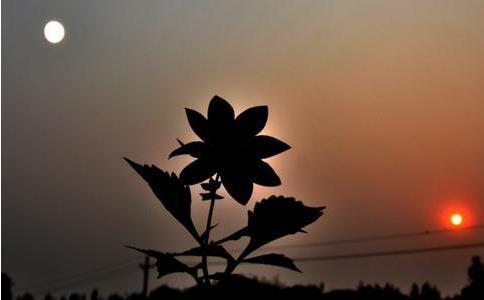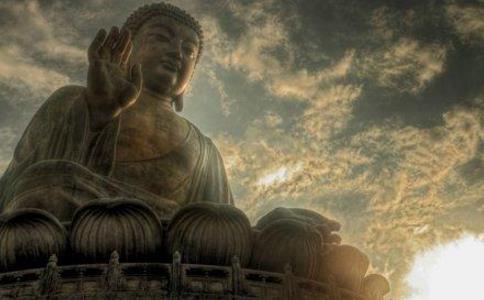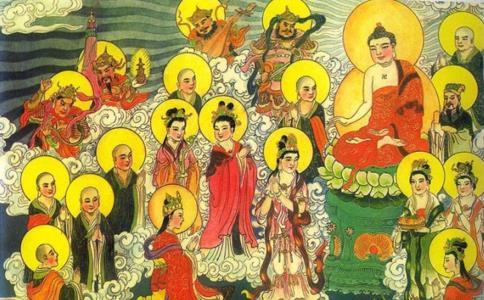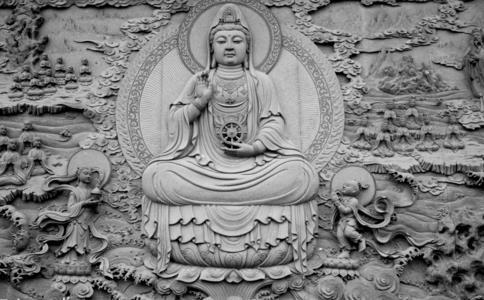论《坛经》禅学思想对般若与佛性的会通
戴传江
佛性与般若是贯穿整部《坛经》的两个重要概念, 惠能对它们作了相互贯通的阐释。佛性本合中道般若, 佛性不二, 心性不二, 自心不二; 般若之非有非无也在于显现佛性, 般若与佛性体用一如相辅相成而为《坛经》顿悟解脱论的理论基础。
《坛经》是唯一由中国僧人撰写并称之为经的佛教典籍,它既是佛教中国化的逻辑结论,又是中国佛教的理论总结。佛教中国化由小乘禅学到魏晋般若学再进至南北朝佛性论,般若学与佛性论成为中国佛教的两大理论支柱。般若与佛性在印度佛教中一般归入空宗和有宗,两者在理论上具有较强的独立性,但佛教传入中国是多头并进、数典并弘的,在佛教中国化的过程中,各学派或宗派在佛学思想上虽各有偏重,但摄空融有、会通般若与佛性却成为中国佛教的一个重要趋势,惠能禅学的创立则是这种趋势的最终完成。惠能禅学以非有非无的中道观来阐释佛性,将实相无相与心性本净相结合。佛性不二,心性不二,自心不二;般若是即有即无、非有非无的不二之智,因此,般若与佛性也是不二,它们体用一如地融会于当下一心而成为顿悟成佛的重要依据和价值指向。
一、般若与佛性会通的历史渊源
中观般若学应归于龙树、提婆所创立的中观学派,该派发挥了般若类经典的缘起性空思想,以八不来破除一切邪见,用《般若经》的真俗二谛说把性空与假有统一起来,并发展为非有非无的中道观。佛性论一般归于有宗的涅槃佛性论这一系思想,佛性论的兴起本身是对空宗诸法性空思想的反动,诸法性空的流弊是一切皆空,甚至连佛、佛法也要空掉,这对佛教本身也是一种威胁,其微弱的中道实相难以弥补空的负面影响。佛性-如来藏思想转向对成佛主体的肯定,虽然它因具有较浓厚的印度神我论色彩而很快被唯识学所取代,但佛性思想的广泛张扬使得佛性论与般若学并列为整个佛学的两大基本理论。佛性论发展于般若学,对佛性的论述必然对般若学有所承继。《涅槃经》中说:
佛性者,名第一义空,第一义空名为智慧。智者见空及不空、常与无常、苦之不苦、我与无我。空者一切生死,不空者谓大涅槃,乃至无我者即是生死,我者谓大涅槃。见一切空,不见不空,不名中道。乃至见一切无我,不见我者,不名中道。中道者,名为佛性。
此处把中道就是佛性,这有着般若学的渊源。大乘般若学虽然倡导诸法性空,但它又在非有非无的诠释中以超四句、绝百非、无形无相、忘言绝虑为实相,从而为通向涅槃之有提供了契机。《大智度论》中说:一切诸观中,空观为第一;一切诸法中,涅槃为第一。
上述般若与佛性的关系只能算作学术思想发展中不自觉的上下贯通,而到被后世禅宗先驱楞伽师所宗奉的佛教典籍《楞伽经》中,般若与佛性则明显具有会通的趋势。《楞伽经》有把如来藏与阿赖耶识合二为一的倾向,经中认为,如来藏(佛性)自性清净,但其为无始虚伪恶习所熏,为客尘所染,便成为生起一切法的阿赖耶识而有一切善不善之因,修行在于以般若之智破除对言相及诸法的执著而使得如来藏自性清净。此处的般若与佛性会通虽然表现在功用上,但它为《坛经》深层次融会般若与佛性提供了重要的理论渊源。
中国佛教大乘中观般若学的真正确立则始肇于罗什。罗什除广译大乘般若学经典及大力阐发般若中观学说外,还翻译了许多佛性-如来藏系经典,其弟子则各有所长但他们的学说也有相互贯通的趋势。僧肇在阐发非有非无的中观思想中已显中道实相的端倪。竺道生被誉为中土涅槃圣,但他本从罗什学习般若学,深得般若学扫相绝意之精义。体法为佛,法是佛性,法即佛,当理为佛,理为佛因,理即佛,佛及佛性的含义与般若之义多有相通。隋唐时代相继建立的中国佛教宗派以六经注我的态度融摄空、有两家思想。三论宗虽独宗中观般若学但又以中道为实相;天台宗的性具说本就是以中观会通佛性的产物;华严宗主张法界缘起说但又重视十玄观法。禅宗先驱楞伽师宗奉《楞伽经》,从东土五祖到神秀北宗,其禅学思想中会通般若与佛性的态势愈为强烈,其中江南般若三论系的法融牛头禅对惠能禅学的影响为最大。在惠能之前,般若与佛性虽互助互称但分属认识领域和心性领域,惠能禅学的建立使般若与佛性真正实现了融合。
二、以体极为宗的般若思想
惠能禅学改变过去楞伽师宗奉《楞伽经》的传统而宗奉《金刚经》该经内容展示一种性空幻有、凡所有相,皆是虚妄的般若智慧,也倡导心无所住、离相无念、扫相破执的修行脱论。《坛经》中般若思想对此多有承继,其中包括空的观念和中道思想,中道思想又延及二谛观、三无观和三科三十六对禅法。惠能般若思想的最大特点在于由般若的顿悟而达佛性的顿悟。
首先,《坛经》继承了传统般若学的诸法性空思想。《般若品第二》中说:
诸佛刹土,尽同虚空。世人妙性本空,无一法可得,自性真空,亦复如是。须弥诸山,总在空中。世人性空,亦复如是。
此处的空既是法空(诸佛刹土,尽同虚空)又是我空(世人性空);既是相空又是体空(自性真空),但《坛经》并不止于体空,而是继承了般若学的中道思想,以中道释空。《般若品第二》中说:
善知识,莫闻吾说空便即著空。第一莫著空,若空心静坐,即著无记空。
《机缘品第七》中说:
世人外迷著相,内迷著空。若能于相离相,于空离空,即是内外不迷。
也就是说,于空离空于相离相的中道智慧才符合真正的般若精神。这种即有即无、非有非无的中道思想又具体体现于《坛经》的三无思想、二谛观及三科三十六对禅法之中。
三无思想即无念、无相、无住。
《定慧品第四》中说:
无念者,于念而无念。于著境上,心不染,曰无念。 无相者,于相而离相。外离一切相,名为无相。能离于相,则法体清净。此是以无相为体。 无住者,人之本性。于诸法上,念念不往,即无缚也。此是以无往为本。
三无思想的实质就是既不离诸法,又不执著诸法,即有即无;既要看到诸法的空性,又不可执著于空,非有非无,如此才能证入般若实相。无住无相本是《金刚经》中的重要概念,惠能在此基础上发挥出无念这一概念并把它与佛性联系在一起。《定慧品第四》中又说:
无者无二相,无诸尘劳之心,念者念真如本性。真如自性起念,非眼耳鼻舌能念。真如即是念之体。
般若由无相无住进入无念从而勾通真如自性,因为真如本为无念之念。
二谛指真、俗二谛。按中观学理论,既不可执著于世俗诸法,必须认识到诸法的性空,又不可否定诸法的幻有,而是借假修真,不离假而求真。《坛经》倡导不立文字,直指人心,反对人们执著于佛教经典。《般若品第二》中说:一切修多罗及诸文字,大小两乘,十二部经,皆因人置。因智慧性,方能建立。若无世人,一切万法,本身不有。但是,惠能又反对完全排斥经典。《机缘品第七》中说:若全著相即长邪见。若全离空,即长无明,执空之人有谤经,直言不用文字。即云不用文字,人亦不合语言。只此语言,便是文字之相。又云直道不立文字,即此不立文字,亦是文字。见人所说,便即谤他言著文字。汝等须知自迷犹可,又谤佛经。不要谤经。罪障无数。正确的做法是既依经典,又不执著于经典,深入到经典的本义之中,反观自心。所谓心迷法华转,心悟转法华。《坛经》中不离世间觉的修行观也体现了这一思想。出世不离世,入尘不染尘,在滚滚红尘中即身成就。三科指阴、界、入三方面,它是惠能禅学借用唯识学对客观世界和精神世界的划分。阴也译作蕴,即色阴、受阴、想阴、行阴、识阴五阴;界指十八界,包括六尘、六门、六识;入也译作处,指六根和六境。世界万法可以以三科作总的划分,而其中又有三十六对之分。语言法相十二对,外境无情五对,自性起用十九对,总计三十六对。例如,天与地对,日与月对,有与无对,有色与无色对,邪与正对,痴与惠对。[vii]惠能对世界万法二元对立的划分实际上是让人们超越世俗二分对立的思维,帮助人们出没即离两边,以达到究竟二法尽除,达到直契本性的境界。这是惠能非有非无中道观在具体禅法上的应用。
惠能禅法中道观要求离两边而处中道,能于相而离相,于念而离念,则可由无相、无住进至无念而得现自性。般若以现性为宗极,但无相、无住与无念并非循序渐的关系,而是体(无念、真如)用(无相、无住)一如的关系,即体即用,一心无相,则同时具足无住、无念;一心无念,自性得显,则同时无相、无住,其内在的根据则在于其特有的佛性论。
三、非有非无的佛性论
《坛经》在佛性论上主张佛性平等(一切众生皆有佛性)和佛性清净,但这也是竺道生以后中国佛性论的主流思想。惠能的革命性在于把抽象的、本体性的佛性拉向人的自性,自性就在于众生现实的当下一心。惠能南宗禅法因契合了中国传统文化的心性论和入世情怀而成为中国佛教的代表。但是,惠能禅学的革命性还应该在于其以非有非无的中道观阐释佛性,融般若与佛性一如于当下一心,并以此作为其顿悟解脱论的理论支柱。
首先,佛性是不二之性。《行由品第一》中说:
法师讲《涅槃经》,明佛性是佛法不二之法。佛性非常非无常,事故不断,名为不二。一者善,二者不善。佛性非善非不善,是名不二。蕴之与界,凡夫见二,智者了达其性无二。无二之性,即是佛性。
即佛性是非善非恶、非常非无常的不二之性,此理本就是中观之道。天台智者大师也力图以性具论将中道观融进佛性论之中。《观音玄义》中说:
阐提断修善尽,但性善在。佛断修恶尽。但性恶在。
即修得成佛的人,他本性中善因子得到完全显现,但恶的因子并没有消除,仍然潜在自身之中。但是,此结论与印度佛教佛性即实相和佛性本净的含义不符,而且也不完全符合中观思想。惠能的不二佛性论则使般若与佛性达到精细圆融的理论层次。佛性不二与佛性本净并无矛盾,它们是从不同层面对佛性的解读。
其次,心性不二。佛性落于自性,自性就在于当下一心。自性虽本来清净但又有迷觉不同,自性之迷觉又在于现实之心的清净与污染。自性与自心是二不离一、一不离二的关系。《疑问品第三》中说:
心是地,性是王。王居心地上,性在王在,性去王无。性在身心存,性去身性坏。
性是心的本质,没有性的心就不是心,没有性的心也是不存在的,修行在于自心回归自性。性与心是一体多相、一实多名的关系,一心染即自性迷,一心净即自性觉,故顿悟就在于当下一心。
再次,自心不二。修行在于修心,修心又在于修不二之心,不二之心就是于相离相,于空离空,不落两端,具足不二。不落两端首先在情感上表现为超越好恶、贪厌、谄佞等心态,常见自心过愆,不见他人是非好恶,即亦见亦不见。《坛经》中记载惠能曾举杖打神会三下并问痛与不痛,神会答为既痛又不痛。惠能认为,不痛即同木石,痛即同凡夫。神会答法本不错,但关键是他以理论认识来作答,而不是从自性上去体悟。此不二之心论也存在于惠能弟子神策与禅者智隍有关入定的对答之中。玄策认为,若无心入定,一切无情草木瓦石应合入定;若有心入定,一切情识含识之流亦应得定;若不见有有无之心,即是常定。惠能之禅定则是妙湛圆寂,体用如如,不出不入,心如虚空,亦无虚空之量。
《坛经》以不二来统摄佛性、自性和自心,自心若处处不二,时时不二,自心就是自性,自心就是佛性,自心之不二就是中观之智,所谓一念觉众生即佛,一念迷佛即众生。
四、融般若与佛性于一心的顿悟解脱论
惠能以非有非无的中道观融会佛性论,佛性是不二之性,般若是不二之智,不二之义是融会两者的内在根据。佛教终极价值的实现在于当下一心的顿悟般若与顿现佛性,但般若与佛性在这一心的顿悟中又处于什么关系呢?在佛性论上,惠能主张即心即佛,佛性平等。《般若品第二》中又说:
菩提般若之智,世人本自有之。一切般若智,皆从自性而生,不从外入,莫错用意,名为真性。
佛性与般若都为人之本有,都存在于人的自性之中,但般若与佛性并不是不同的两者存在于自性当中,它们本为一体,就是人的自性,只不过是对自性的不同解读而已。《行由品第一》中说:
无上菩提,须得言下识自本心,见自本性,不生不灭,于一切时中,念念自见,万法无滞,一真一切真,万境自如如,如如之心即是真实。若如是见,即是无上菩提之自性也。
修行无论是从涵养心性入手还是从体悟般若入手,两者都是互助互成的。若从个人心里上看,当你心中充满烦恼而自性有染时,你可以以般若学为认识论来看待所面临的人和事,当你真正能看开时,你此时才真正体会到般若之智,而你此时的心性也必然是清净的。
上述体用一如的思维方式还可从《坛经》的定慧观中略见一斑。《定慧品》中说:
我此法门,以定慧为本。第一勿迷,言定慧别。定慧体一不二。即定是慧体,即慧是定用。即慧之时定在慧,即定之时慧在定。
惠能在此处对定慧作了区别于传统的阐述,定慧是体用相即的关系,成就智慧则心性自然安定,心性安定时则必具智慧,两者互助互成,体用不二。般若与佛性之关系同于此理,顿悟般若时自性必顿现,顿现自性则般若自具。敦煌本《坛经》中记惠能偈两首,其中之一为:
菩提本无树,明镜亦非台,佛性常清净,何处有尘埃。 敦煌本后的各版本《坛经》中则将佛性常清净改为本来无一物。后人对此争议较大,有人认为其以般若思想窜改了佛性论而有失惠能的原义。事实上,从惠能融会般若与佛性的思想来看,所改并未离开惠能本义,只不过强调重点略有不同而已。清净在于佛性的存在状态,无一物在于佛性的存在方式,改后反而更为符合惠能的顿悟般若顿现佛性思想。
般若与佛性体用一如地归于众生的当下一心,修行就在于修当下的一心。这当下的一心,在认识上无相、无住、无念;在体性上无善无恶,非有非无;在情绪上无喜无悲,虽有相而离相,直达本源,顿悟成佛。惠能之顿悟说强调顿悟菩提,顿见本性,但惠能还主张顿修。当然,顿修并不是指一修即成之意,事实上包括佛陀在内也没有人不需要渐修的。本来正教,无有顿渐,人性自有利顿,迷人渐修,悟人顿契。(《定慧品第二》)此处顿修是指悟前的修行直指当下一心,当下一心又直指般若中观之智,直指无善无恶的清净本性,方法与结果高度统一,但能否统一就是一个渐修的过程了。般若与佛性合于一心的解脱论无论是理论意义还是实践意义都成为中国佛教的重要特征。





